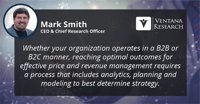Economic dynamics and market pressures during a black-swan event can wreak havoc on efforts to effectively manage revenue operations and pricing for business continuity. For many organizations, environmental changes disrupt the methods by which these essential business processes are managed can be disrupted, damaging the revenue streams that create profitability. The array of pricing strategies and related promotional tactics across channels for configure, price and quote (CPQ), digital...
Read More
Topics:
Sales,
Customer Experience,
Human Capital Management,
Marketing,
Analytics,
Business Intelligence,
Collaboration,
Internet of Things,
Data,
Product Information Management,
Sales Performance Management,
Workforce Management,
Workforce Planning,
Price and Revenue Management,
Total Compensation Management,
Conversational Computing
Over the past several months, I have discussed a wide range of topics that organizations must consider and appropriately prioritize to maintain business continuity during periods of upheaval. But sometimes it’s important to take a step back and reflect on a critical and recurring theme: experiences. The array of experiences across the workforce and business processes both inside and outside of the organization are an essential part of an organization’s success. Leadership must give these...
Read More
Topics:
Sales,
Customer Experience,
Human Capital Management,
Marketing,
Office of Finance,
Analytics,
Business Intelligence,
Collaboration,
Internet of Things,
Data,
Sales Performance Management,
Workforce Management,
Workforce Planning,
Operations & Supply Chain,
Total Compensation Management,
Conversational Computing
Maximizing the performance and value of people in the workforce should be a primary focus for any business these days. It is a complex task, especially for larger organizations, and chances for success can be increased by investment in human capital management (HCM) applications. In this competitive software market SAP is making a strong push, aided by acquisitions in the last three years of SuccessFactors for talent management and more recently Fieldglass for contingent labor management....
Read More
Topics:
SAP,
HCM,
Human Capital Management,
Learning,
Performance,
Recruiting,
SuccessFactors,
Operational Performance,
Analytics,
Business Analytics,
Business Performance,
Cloud Computing,
Financial Performance,
Compensation,
HRMS,
Vendor Management Systems,
Workforce Analytics,
Workforce Management,
Workforce Planning
Human capital analytics used to be simple. It focused on compliance reporting, showed basic information and was an afterthought in most applications. Today analytics is the centerpiece of many human capital management applications and involves many sophisticated tools, because it delivers the some of the greatest value of any process in all HCM. Our next-generation workforce management benchmark research found that 61 percent of companies surveyed are planning to invest in improving their...
Read More
Topics:
HCM,
OrcaEyes,
Analytics,
Business Analytics,
Cloud Computing,
Information Applications,
Workforce Performance,
Talent Management,
Workforce Planning
Gadgets be gone: That was one of my lighter tweetable sentiments from last week’s HRO Today Forum analyst summit, and you’ll see why below. At this gathering we industry analysts discussed the difference in perspectives on innovation, or the lack thereof, held by HR technology suppliers and the HR practitioners who buy and use their products, many of whom attended the HRO Today Forum.
Read More
Topics:
Performance Management,
Human Capital Management,
business innovation,
Operational Performance,
Business Analytics,
Business Collaboration,
Business Intelligence,
Business Mobility,
Business Performance,
Cloud Computing,
Workforce Performance,
Talent Management,
Workforce Planning,
HR technology
Less than a week after attending ADP’s industry analyst day, I flew to Washington, D.C., to attend Mercer’s analyst forum, which gave me a chance to compare another human resources juggernaut. While ADP is known primarily for payroll and business process outsourcing, Mercer is known for HR consulting and benefits outsourcing. Mercer is not as big as ADP, with $3.5 billion in annual revenue and over 27,000 customers, most of which are large multinational and midmarket companies, servicing over...
Read More
Topics:
Performance Management,
Human Capital Management,
Metrics,
Operational Performance,
Business Analytics,
Business Collaboration,
Business Intelligence,
Business Performance,
Financial Performance,
Governance, Risk & Compliance (GRC),
Workforce Performance,
Compensation,
data mart,
Talent Management,
Workforce Analytics,
Workforce Planning
Workforce planning is a business process that done right ensures an organization of suitable access to talent to ensure future business success. At a Mercer analyst summit I attended recently, which I wrote about in “Mercer Promotes Possibility of the New Empowered Workforce,” one of the sponsor execs kept challenging the HR industry analyst community to do more research on workforce planning, since her company and its customers are spending more time and money on just that.
Read More
Topics:
Performance Management,
Sales Performance,
Supply Chain Performance,
Human Capital Management,
Metrics,
Operational Performance,
Business Analytics,
Business Collaboration,
Business Intelligence,
Business Performance,
Customer & Contact Center,
Financial Performance,
Information Applications,
Information Management,
Workforce Performance,
Compensation,
data mart,
Talent Management,
Workforce Analytics,
Workforce Planning
Consolidation in the human capital management software market is in full swing. Recently Peopleclick Authoria acquired Aquire Solutions, and just this week Golden Gate Capital and Infor agreed to buy Lawson Software for about $2 billion, which my colleague Robert Kugel commented.
Read More
Topics:
Performance Management,
Sales Performance,
Human Capital Management,
Learning,
Learning Management System,
Operational Performance,
Business Analytics,
Business Collaboration,
Business Mobility,
Business Performance,
Cloud Computing,
Customer & Contact Center,
Financial Performance,
Workforce Performance,
Compensation,
Talent Management,
Workforce Planning














